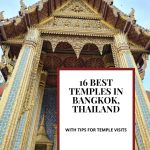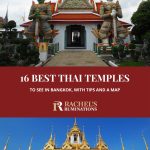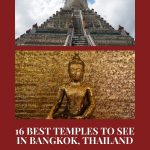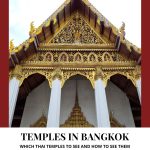16 best temples in Bangkok, Thailand
There are hundreds of temples in Bangkok, ranging from tiny neighborhood shrines to multi-acre complexes. Deciding which temples to see is difficult, and it’s not just about the temple’s beauty. For many of these, it’s about what the temple holds as well.
Disclosure: This article contains affiliate links. If you click on one and make a purchase, I will receive a small commission. This will not affect your price.
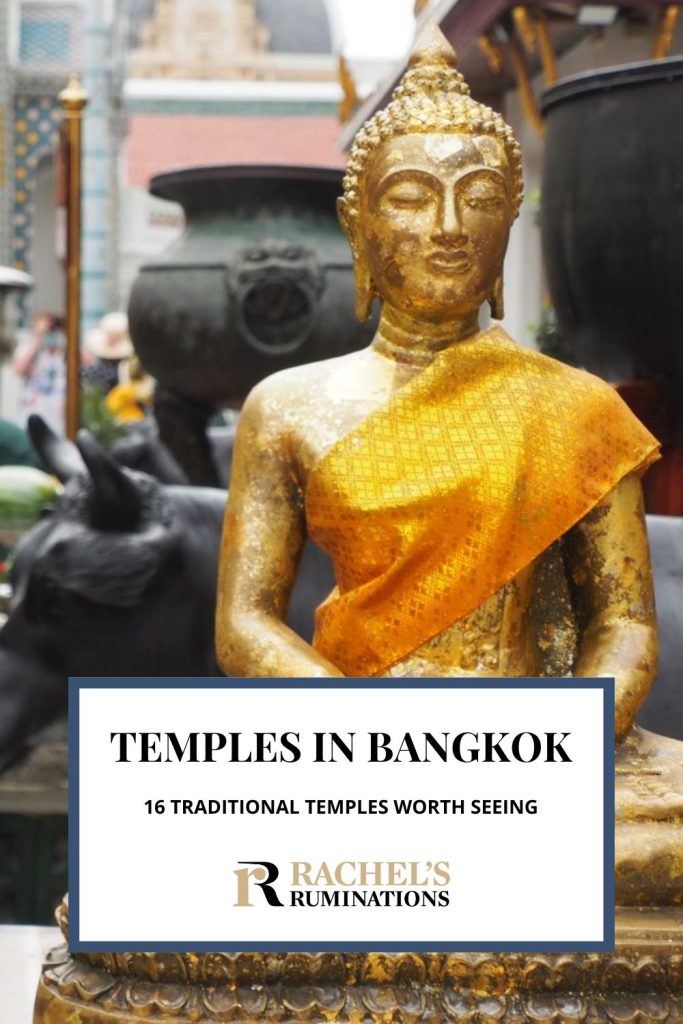
Given that there are so many, which are the best to see? Here’s a list of traditional Thai temples in Bangkok, or rather temple complexes, several of which are on every Bangkok itinerary, but some of which are less well-known. Following the list is some advice about which to prioritize, and also some general tips about visiting temples in Bangkok and Thailand as a whole.
Note: Revised in February 2024. My husband visited many of Bangkok’s temples on our return visit to Thailand, but then went ahead and went to some I hadn’t been to. He felt that some of these also deserved to be on this list, so I’ve added them. So now it’s 16 best temples, instead of 13!
About Thai temple complexes
Traditional Thai Buddhist temples are typically not just a single building, but rather a complex of buildings and the outdoor space around them, usually surrounded by a wall.
An ordination hall is where important ceremonies take place and where monks meditate. It will have one or more Buddha images. You may be allowed to enter the ordination hall, or you may not, depending on the temple. In any case, see my tips later in this article so you know what you can and cannot do in a temple.
The sermon hall (viharn) contains the most important Buddha image(s) belonging to the temple. Many sermon halls and the ordination halls will have their inside walls covered with detailed and colorful images that generally tell stories from the Buddha’s life.
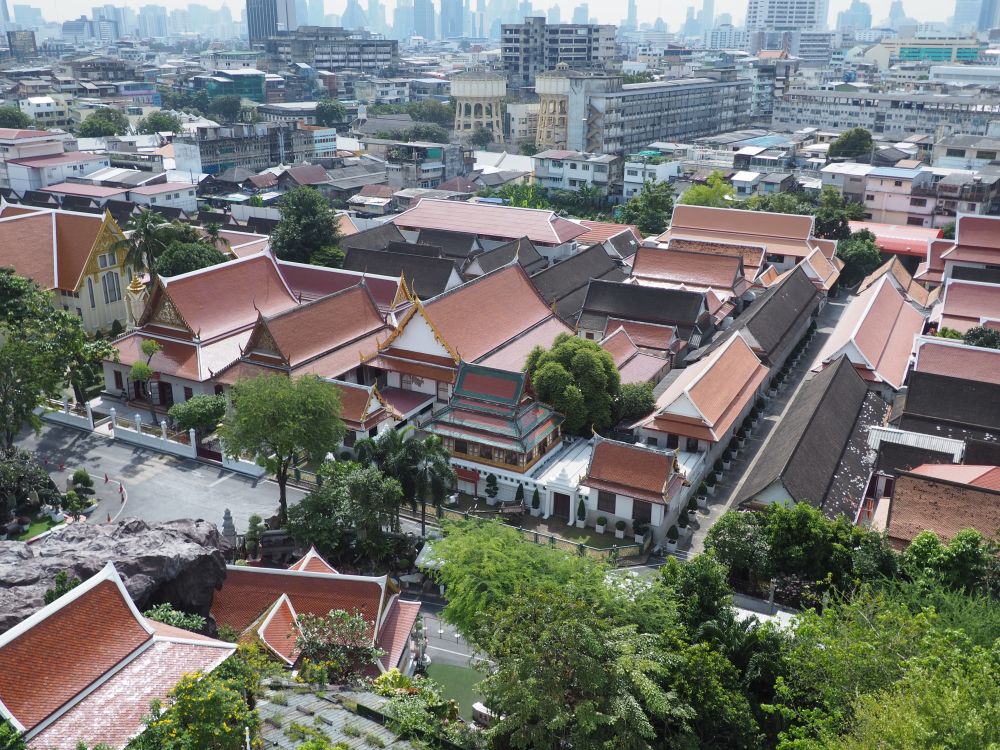
Stupas are towers that hold relics of the Buddha. A stupa might also be called a chedi or a prang, but they’re all variations on a theme. Some smaller ones may serve as tombs, holding the ashes of monks from that particular temple.
Some temples have many sitting Buddha images, each on a small pedestal. These are often tombs as well, paid for by a particular family to contain their ashes.
Outside, around the temple buildings, you’ll often find other areas in use as places of worship, but also as commercial opportunities. They’ll often have a tent-like or metal roof sheltering Buddha images. Believers can buy items like flower chains, food and cloth at stands nearby in or just outside the temple grounds. They leave these as offerings to “make merit.” They buy and light incense and/or candles to set up near the altar. Many temples don’t allow incense or candles inside anymore because of fire danger, so these outside altars replace that tradition.
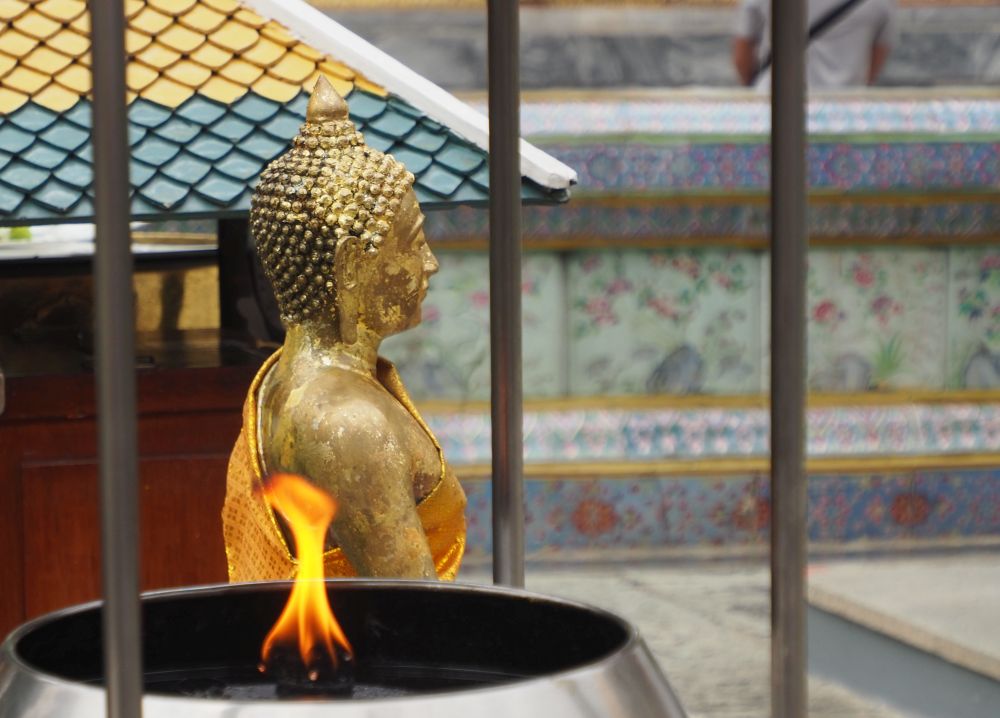
Temples often have a large open-sided hall for sermons and other gatherings. They might also have a bell tower to ring out ceremonies.
The bigger temples will have more buildings to serve more practical functions. If monks train there, for example, their housing and kitchens and such will be inside the compound.
Except where mentioned below, the temples are free to visit, though there is often a box for donations for you to drop in a few bahts.
If temples like these are your thing, make sure to read my article about Nikko in Japan too. And also my article about Chinese temples in Bangkok. And if you particularly like the Buddha images and other statuary you see in the temples, pay a visit to the National Museum Bangkok as well, to see the art placed into its historical context.
1. Wat Arun
Though its official name is Wat Arun Ratchawararam, everyone calls this temple Wat Arun, which apparently means “Temple of Dawn.” It’s easy to spot because of its very tall stupa or prang surrounded by four subsidiary prangs. What’s special about this temple is the decorations on the stupas: they’re covered entirely with porcelain tile pieces. It’s quite a sight to behold, especially at night when it’s brightly lit.

The original temple on the site dated to the 17th century (Ayutthaya period) and was restored in the mid-1800s, when Thailand’s capital city, Thonburi, was here. This makes it not only one of the most famous temples, but also one of the oldest temples in Bangkok. What you see now, though – the tall prang – was finished in 1851, well after the capital moved across the river to Bangkok.
Besides the general beauty of the use of porcelain, notice some of the creatures portrayed on Wat Arun’s prangs and other buildings:
- The images around the base of the prangs, some of which depict demons.
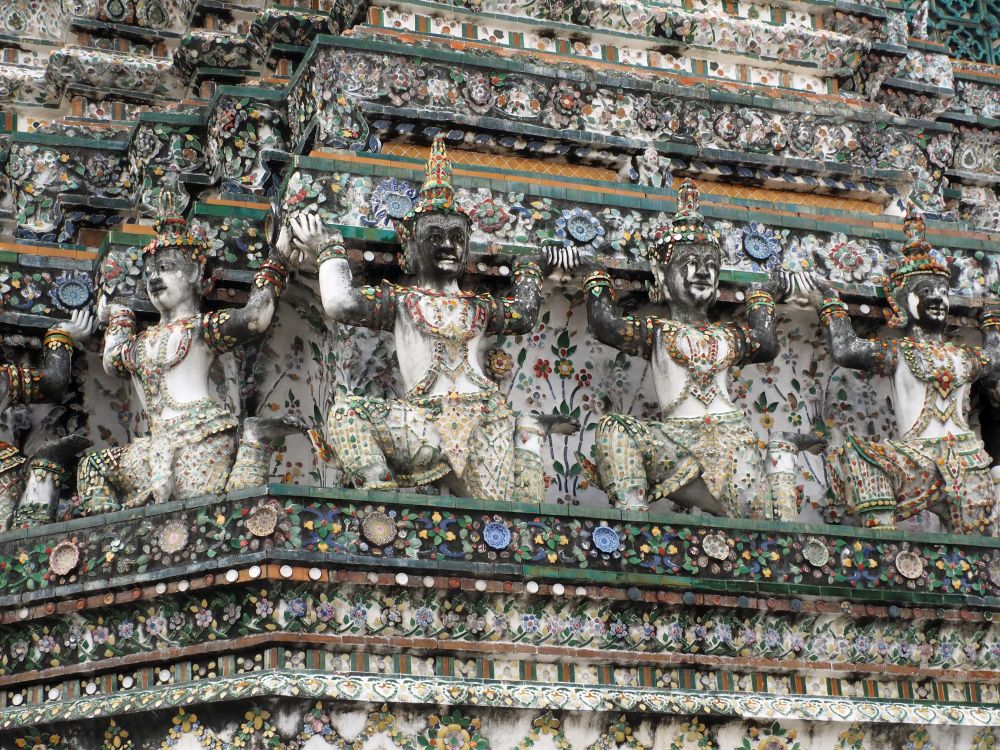
- The subsidiary prangs have images partway up of a horseman of some sort in a niche. I find these quite charming.
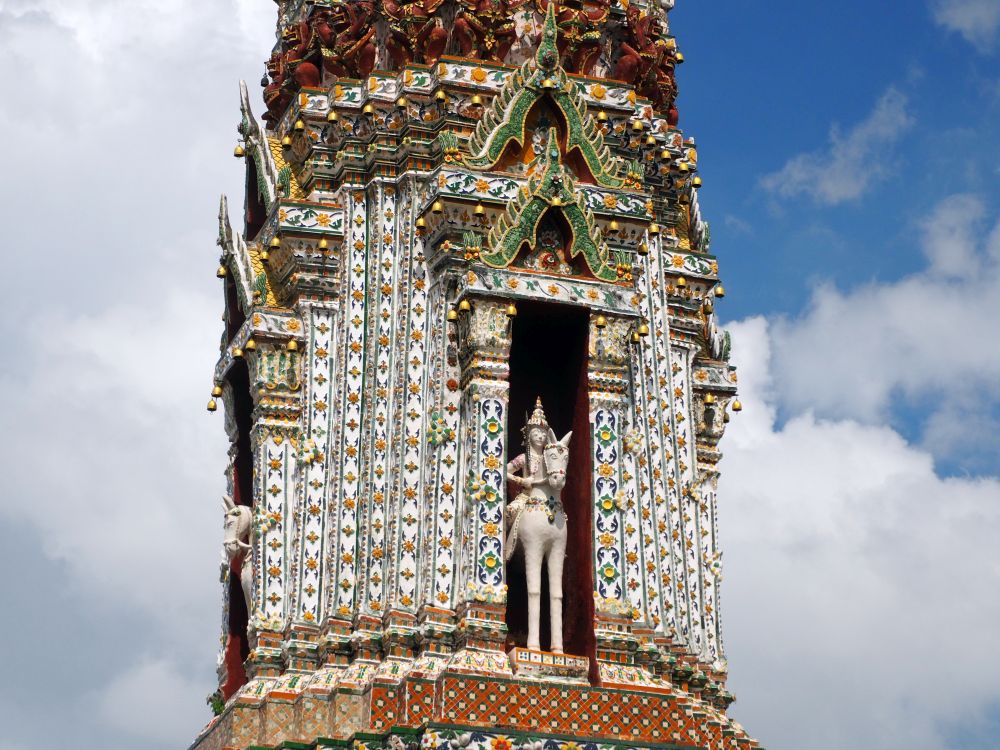
- At the entrance, two huge statues of yaksha, which are good spirits that stand at the entrance of temples to protect them from evil spirits.
You’ll likely be sharing Wat Arun with lots of tourists, both foreigners and locals. When I visited, there were many young Thai people wearing traditional Thai outfits, posing for lots of selfies. I asked one of them why they were doing that. She told me that it was just for the fun of posing in these outfits. She hastened to add that they didn’t normally dress this way.

Open daily 8:00-18:00. Fee: 100 baht. There’s a ferry stop right in front of it.
2. Wat Mahathat
Its full name is Wat Mahathat Yuwaratrangsarit, and this temple complex is ornate and extensive. It’s within the grounds of the Grand Palace, the home of the king once the capital of Thailand moved to this side of the river in 1782. The Grand Palace compound is huge and has a range of buildings, but Wat Mahathat is the section of green-and-red-roofed Thai-style temples on the north side of the Grand Palace complex.
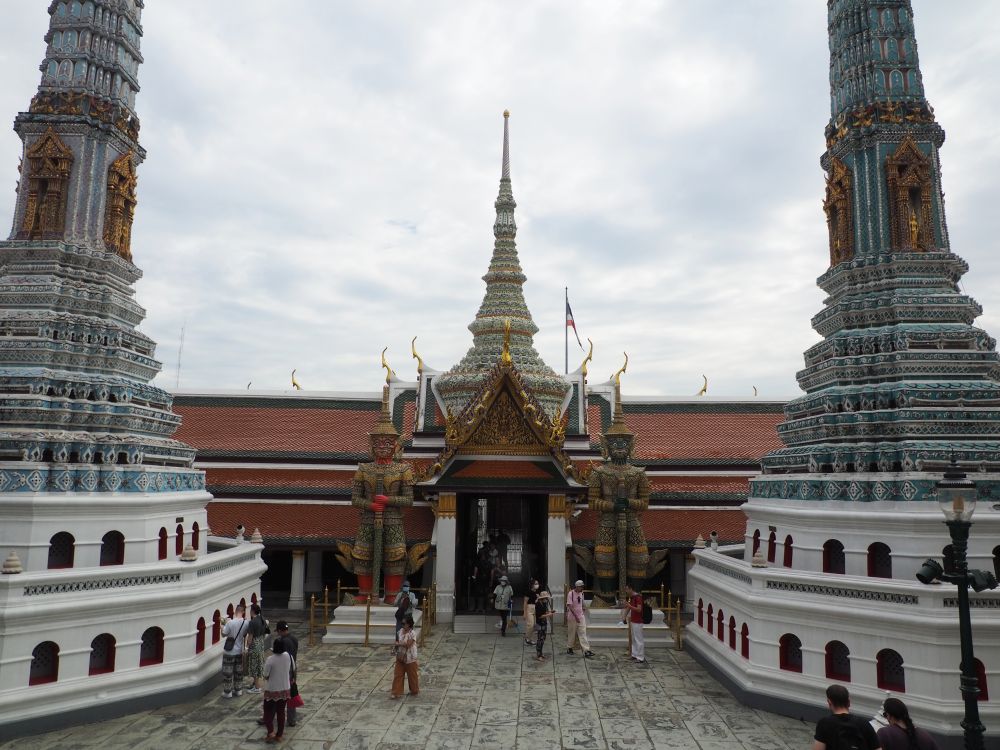
Wat Mahathat dates to the Ayutthaya period (1351-1767). It was renovated and rebuilt extensively in the 18th century, mostly just because it was near the Grand Palace and could be used for official ceremonies concerning the royal family.
When I call Wat Mahathat “ornate,” it’s a bit of an understatement. Parts of the buildings are decorated in ceramic, like Wat Arun, but parts are, for example, inlaid with mother-of-pearl, while some have mosaics of glass and gems or are coated with gold leaf. The Thai multiply-tiered roofs, with their typical upward-pointed decorations at the peaks, along with the consistent roof color, are what brings the various buildings together.
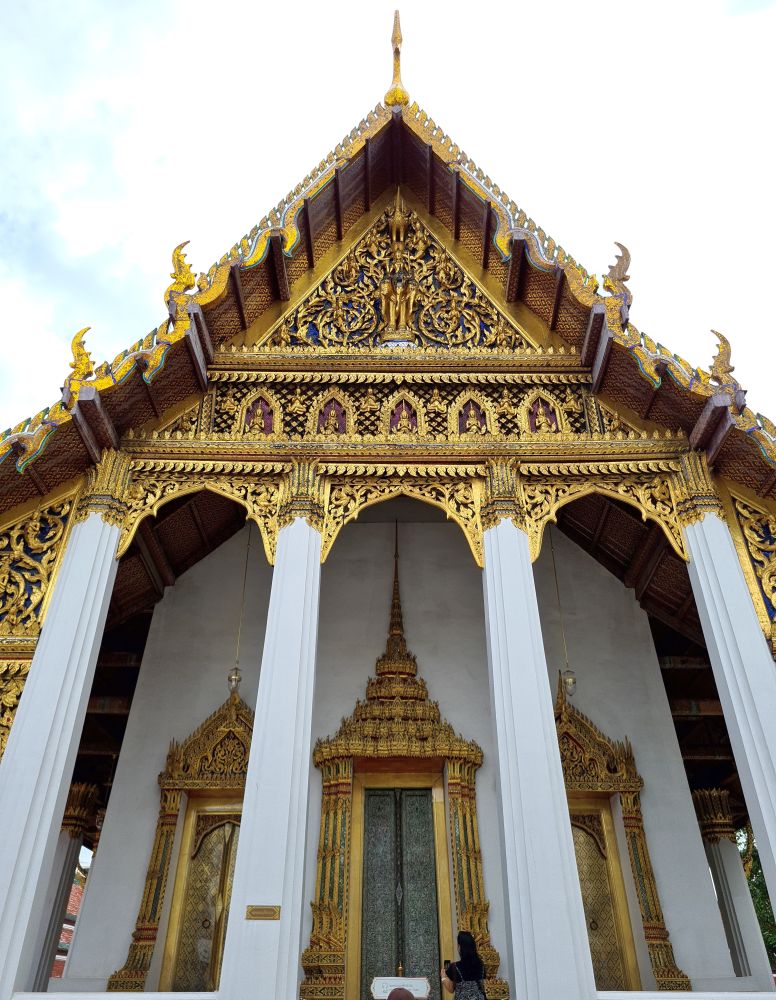
Like at Wat Arun, you’ll find huge yaksha statues and several stupas, one of which is highly decorated and perches on top of one of the temples. Another one is quite simple and unadorned, but painted entirely gold.
Also like at Wat Arun, you’ll face crowds of tourists here. You can buy a combined ticket to see Wat Mahathat, the Grand Palace buildings and grounds, and the Temple of the Emerald Buddha, which I’ll describe next. You could easily spend an entire morning or afternoon here, which probably contributes to how crowded it is.
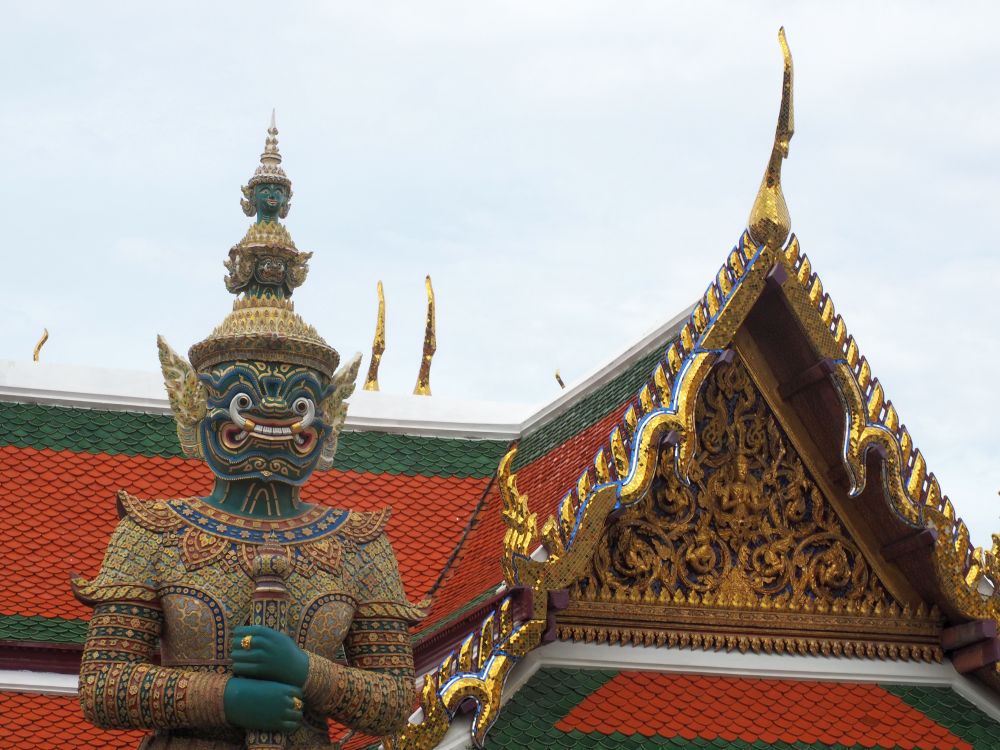
The Grand Palace and the Wat Mahathat buildings are open daily 8:30-15:30. Fee: 500 baht for foreigners; free for Thais. Or buy a skip-the-line ticket ahead of time for the Grand Palace, Wat Mahathat and Wat Phra Kaew (see below). Nearest ferry stop is Tha Chang.
3. Wat Phra Kaew
Wat Phra Kaew is generally known as the Temple of the Emerald Buddha and was built starting in 1783. Strictly speaking, it’s part of Wat Mahathat, but is more important because of the special Buddha image it holds.
Known as the Emerald Buddha, this statue is rather small – about 66 centimeters (26 inches) tall. It’s not made of emerald, but rather jade, and shows a seated, meditating Buddha. It is centuries older than the temple is, though how old isn’t clear. Perhaps it was created in Thailand, or perhaps stems from India or Sri Lanka. It “lived” in northern Thailand for an unspecified amount of time, then spent hundreds of years in Laos before Thailand conquered Laos and took the statue back. Its current home, Wat Phra Kaew, was built specifically to house this Emerald Buddha statue.
The temple, meanwhile, is even more ornate than Wat Mahathat, and it’s worth taking the time to admire the workmanship on and inside the building itself. The building and many of the decorations shine with gold leaf.
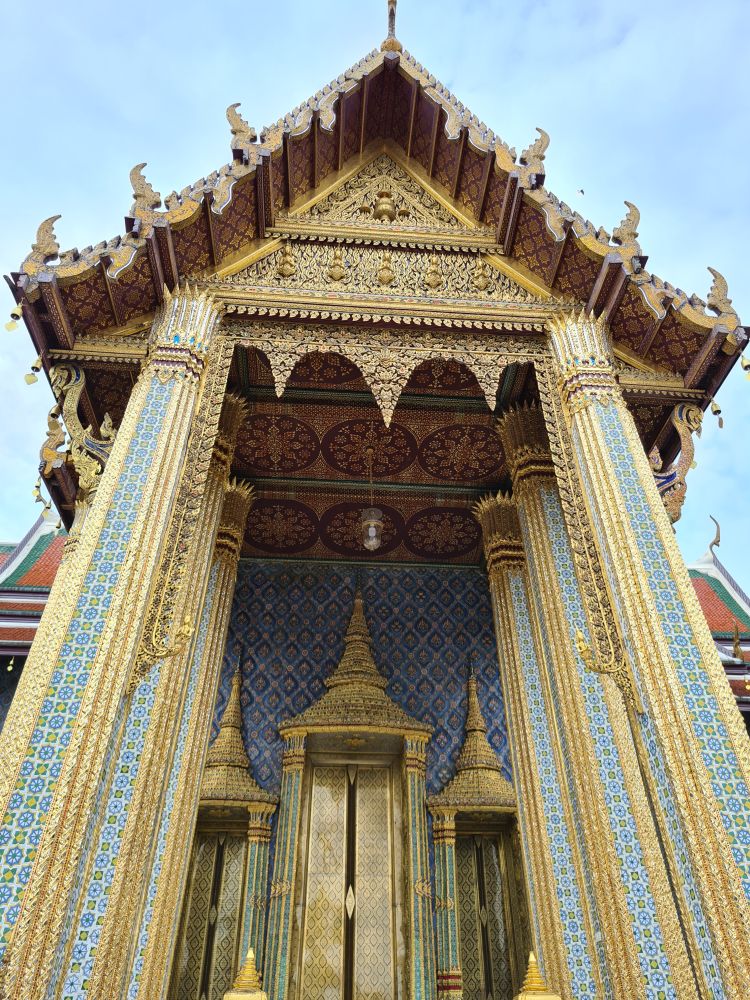
The ticket to the Grand Palace includes admission to the Temple of the Emerald Buddha. It costs 500 baht for foreigners and is free for Thais.
4. Wat Pho
The original temple on the site of Wat Pho (Full name: Phra Chetuphon Wimon Mangkhalaram Rajwaramahawihan, but Wat Pho is short for its old name, Wat Photaram.) dated to the 17th century. After the Burmese invasion destroyed Ayutthaya in 1767, King Taksin moved the country’s capital to Thonburi, just across the river from Wat Pho.
King Rama I rebuilt Wat Pho in 1788-1801 after he moved the capital again, this time to Bangkok from Thonburi. He also added what Wat Pho is most known for: the Temple of the Reclining Buddha. The gold-painted Buddha inside this specially-built temple measures 46 meters (151 feet) long. The reclining Buddha pose isn’t so common in Thai temples in Bangkok. It depicts the Buddha just before reaching nirvana.

The complex is huge, with lots of stupas, halls and gardens, and it houses 1000 Buddha images (including the reclining Buddha). King Rama I brought many of them here from the old capitals, Ayutthaya and Sukhothai.
Wat Pho is also the birthplace of Thai massage. The school within the complex offers training courses in massage or other aspects of traditional Thai medicine to this day. You can also get a Thai massage right here at the source.

The Buddhas in the photo above are in the “Subduing Mara” or “Overcoming Mara” pose: sitting cross-legged with the right foot on top, left hand resting in his lap, palm up, right hand palm down on the right knee. This has to do with a story of Buddha resisting the temptations presented by Mara, a demon, at a moment of meditation when he was very near achieving enlightenment. This is the pose you’ll see most at Thai temples.
Open daily 8:00-18:30. Admission fee 200 baht.
5. Wat Saket
Also known as Golden Mount, Wat Saket is a bit different because it perches on the only hill in Bangkok.
The original temple on the spot dated to the Ayutthaya period, but the hill wasn’t built until the late 18th century. The large stupa on the hill dates to the late 19th century, and the more modern temple wasn’t built till the early 20th.
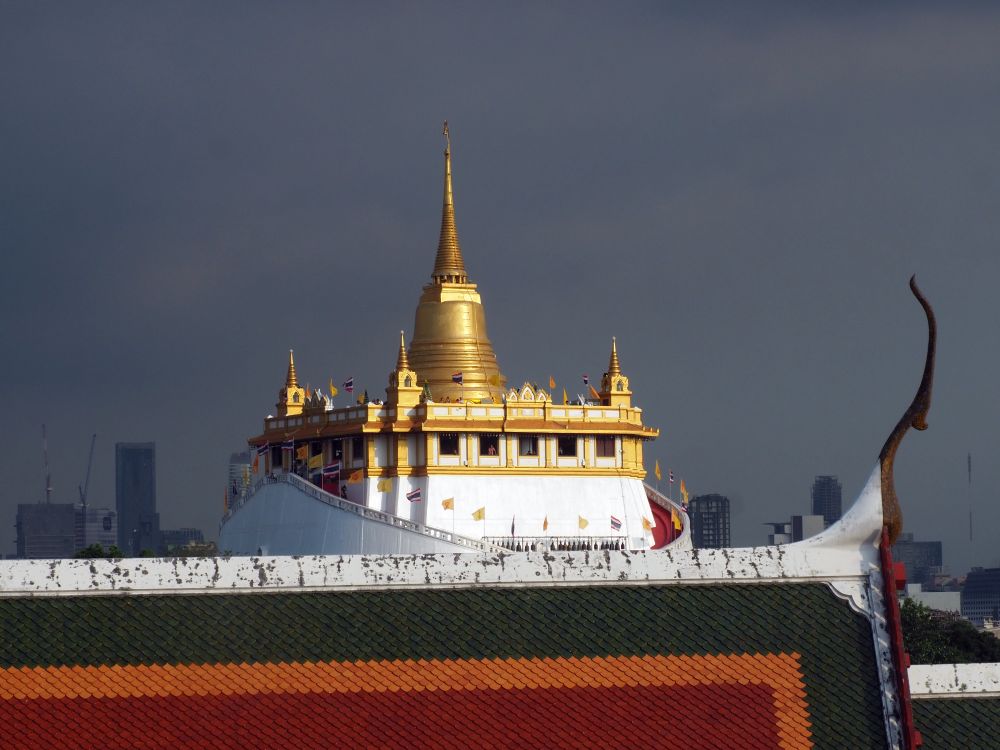
This temple houses some Buddha relics, but generally isn’t as ornate or interesting as the ones I’ve listed above. What makes this temple special is its height, and the view it offers.
It takes about 320 steps to climb the mount, and by going inside the stupa, you can climb a short stairway to come out on the roof, at the base of the stupa. From there you’ll get a 360-degree view of the city.
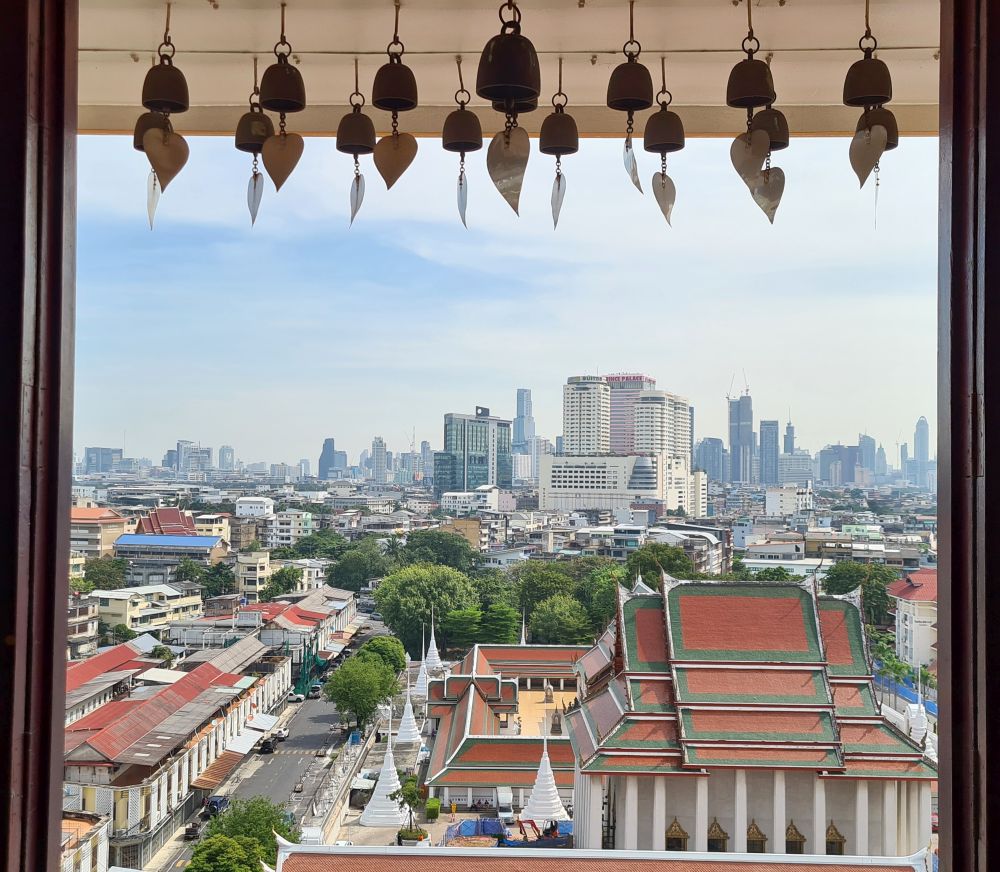
The rest of the complex is below the mountain and contains some ornate temples and a few quite large Buddhas, including a very large standing one.
Open daily 7:00-19:00. Admission: 200 baht.
6. Wat Ratchanatdaram (Metal Palace)
The central building in this temple complex is the main attraction, in a different architectural style from any other temple building. It’s called Loha Prasat, but it’s more commonly known as the Metal Palace or Metal Castle. With three high levels in the form of a square pyramid, metal spires top each level: 24 on the bottom level, 12 on the middle level, and one central spire on the top.
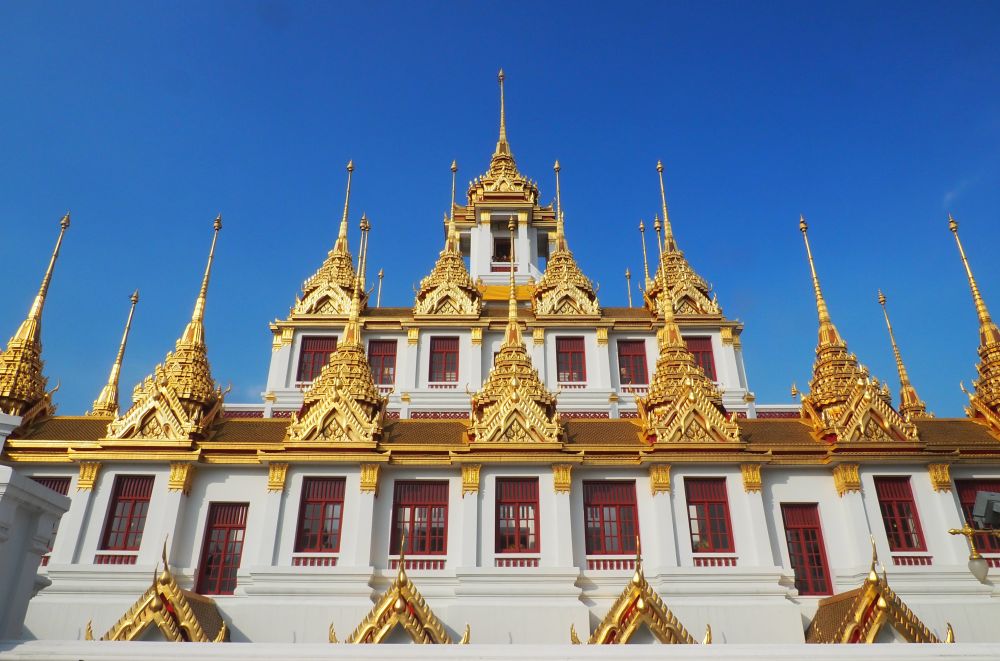
While traditional temples and related buildings surround it, the Metal Palace itself isn’t really a temple in the traditional sense. It’s more a place of learning about Buddhism. Each floor has a grid of pillars and hallways between them whose walls carry plaques explaining various elements of Buddhist belief: 37 virtues leading to enlightenment, which is why there are 37 spires on the building.
From the top level you can get a great view, including a view of the Golden Mount.
Open daily 8:00-17:00. Admission: 20 baht.
7. Wat Traimit
Wat Traimit (short for Wat Traimit Witthayaramworawihan) dates to 1832. It is worth a visit for two reasons. It houses a museum all about Bangkok’s Chinatown, and it houses the famous Golden Buddha.
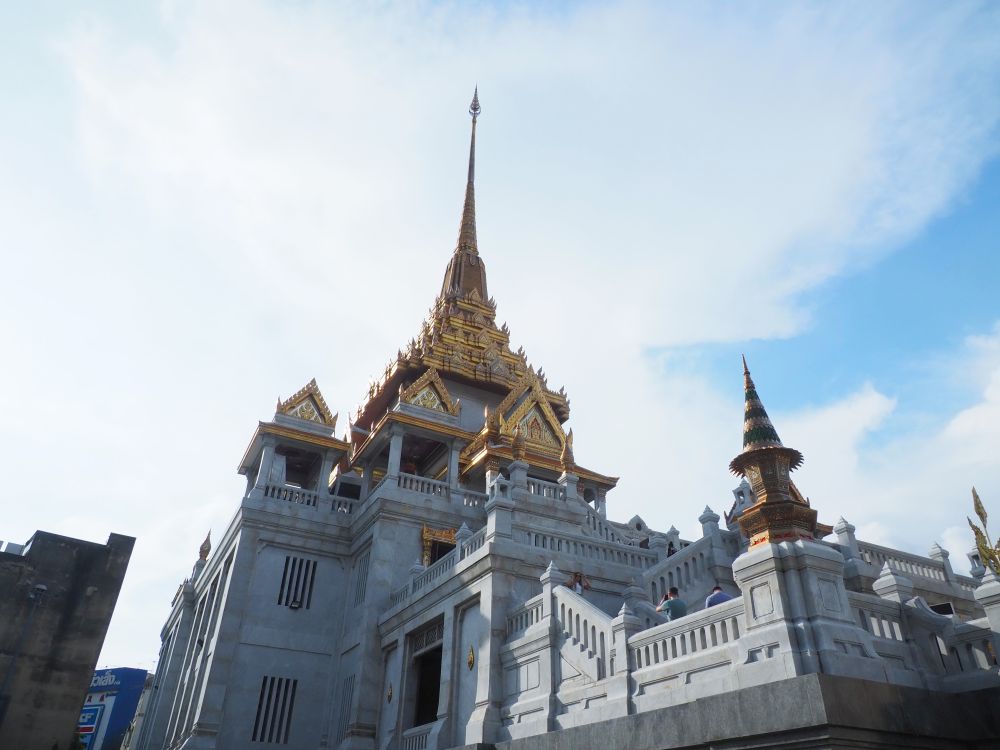
Yaowarat Chinatown Heritage Center
The museum is remarkably well-done, with text explanations about how and why the Chinese community came to be in Bangkok, but also containing life-sized mock-ups of typical Chinatown scenes, complete with very realistic waxworks of the people involved.
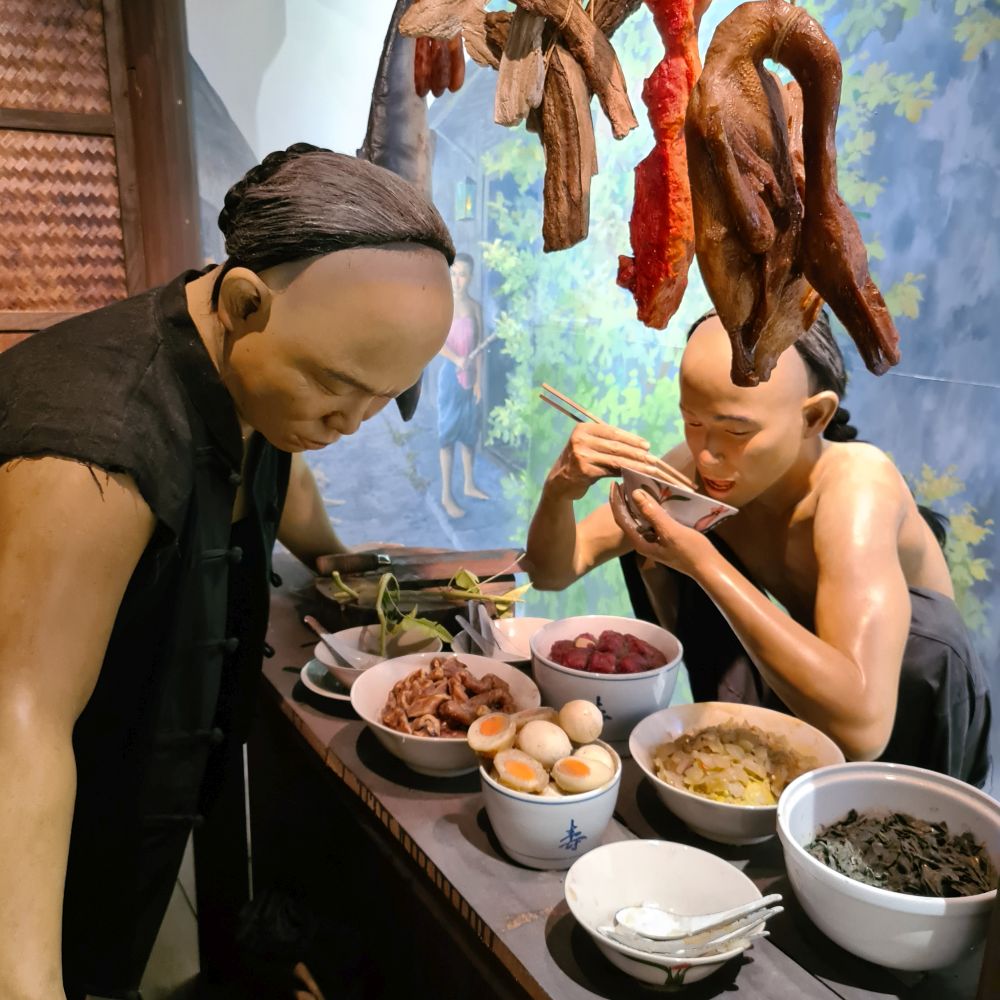
Read my separate article about the Chinese temples in Bangkok, which are very different from the Thai-style temples.
The Golden Buddha
The Golden Buddha is just what it says: a Buddha image made of pure gold – unlike the other images you’ll see at every temple that look golden but are actually just gold-leaf over plaster or bronze.
It also has a great story to go with it. It’s in the Sukhothai style, so probably created during the Sukhothai period. It’s assumed that one of the kings of Sukhothai must have commissioned it, since it’s made of solid gold.
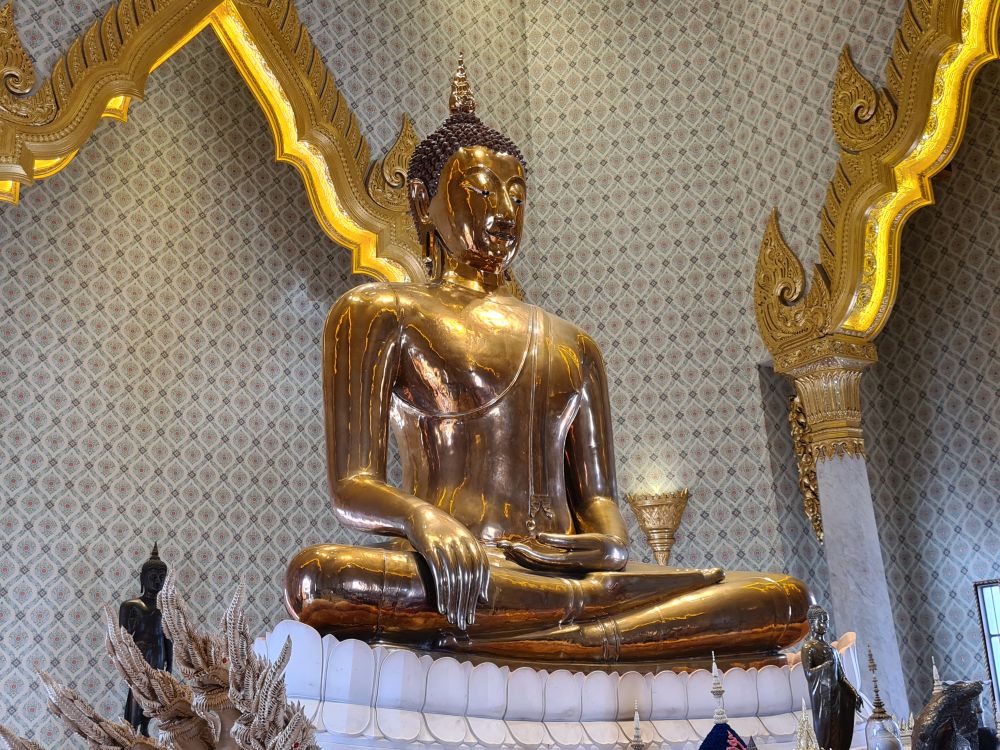
The Buddha was probably taken to Ayutthaya when the capital moved there from Sukhothai. However, at some point it was plastered over, lacquered and covered in gold leaf. There are two possible stories for why this happened:
- It may have been done in order to hide the image when Ayutthaya invaded Sukhothai in the 15th century.
- Alternatively, it may have been brought to Ayutthaya in its original form and plastered over when the Burmese invaded Ayutthaya in 1767.
In either case, from that point it sank into obscurity, treated like any other old Buddha image, ending up in the 1800s at a temple in Bangkok.
It wasn’t until 1955, when it was being moved to Wat Traimit, that it fell and the plaster chipped, exposing a bit of the gold inside. Investigators removed all the plaster to reveal the original gold image, made of several parts that fit neatly into each other.
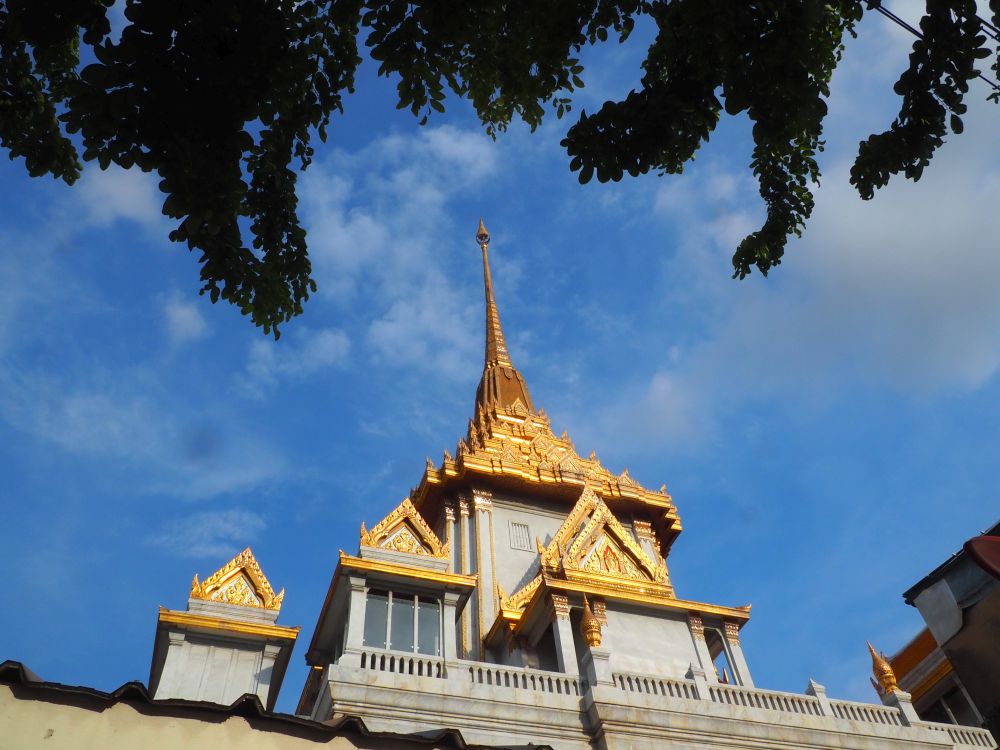
In 2008, the image was transferred to its current home: a specially-built pavilion at Wat Traimit. It’s the same building that houses the museum, and also includes a small exhibition about the Golden Buddha’s story.
While the style of the plastered-over version was in Ayutthaya style – square face, thick lips, and rather bulbous nose – the golden statue underneath is in classic Sukhothai style: curled hair; a flame aureole (the thing on his head); a slight smile; a narrow, slightly hooked nose; arched eyebrows that meet; and a robe over one shoulder that reaches down to the navel. The pose is a classic “Subduing Mara” pose.
The Golden Buddha is 398 cm tall (157 inches) and weighs 5.5 tons. If I’m figuring right, that makes it worth about $58 million just in terms of the value of the gold.
Open Tuesday-Sunday 8:00-17:00. Admission: 40 baht.
8. Wat Bowonniwet Vihara
This is one of the ones I didn’t visit, but my husband did. Here’s his description:
This temple was one of the first I visited and I was struck by the beautiful gold-coloured chedi that stands between two symmetrical chapels. It was constructed around 1825 during the reign of King Rama III. It houses Thailand’s second Buddhist university and quite a few kings served their monkhoods here.
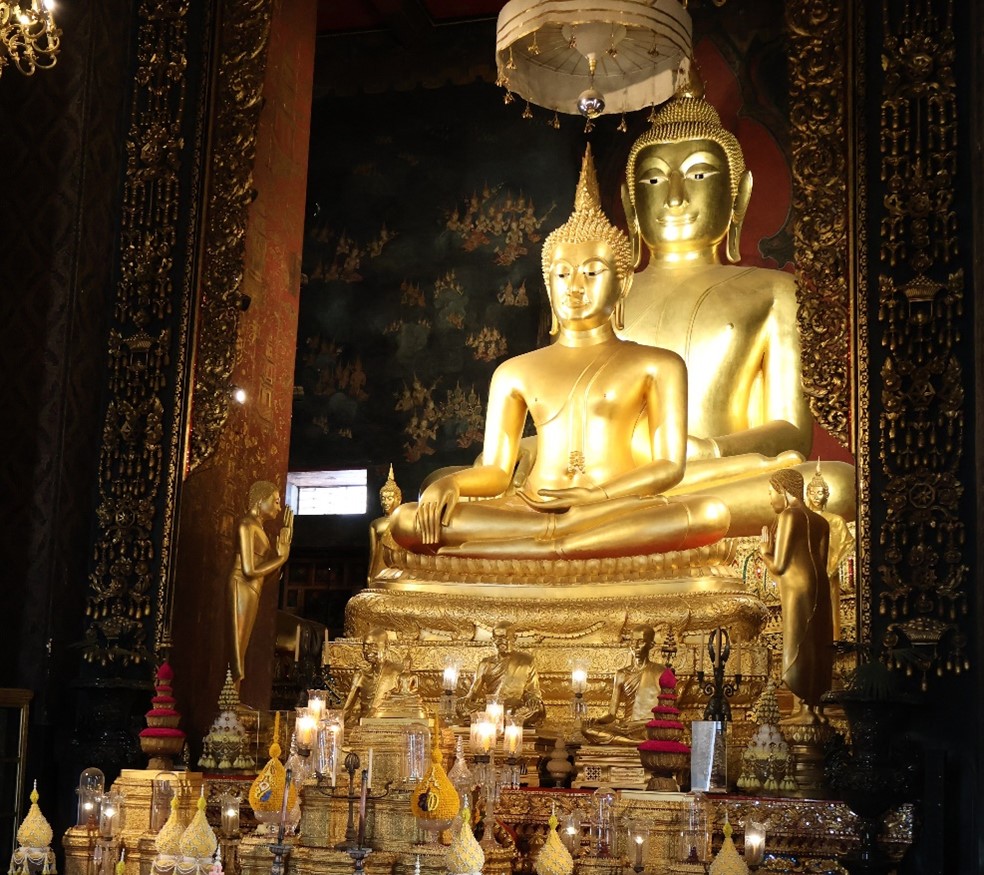
In contrast to some of the larger temples I had this one almost entirely to myself. The windows of the temples are beautifully decorated and inside the Bot (ordination hall), you will find two large Buddha images. The Phra Buddha Chinasara dates back to the Sukhothai period (ca 1250) . Inside the temple, there are somewhat western-looking murals depicting the life of Buddha.
Open daily 8:00-17:00. Free admission.
9. Wat Thepthidaram
Wat Thepthidaram, a.k.a. Wat Thepthidaram Worawihan or Wat Phraya Krai Suan Luang, is another pretty temple, this one perhaps the furthest off the beaten tourist path of any temple on this list. While the temple was founded in 1839, its principal Buddha image in its ordination hall is made of white stone and is probably centuries older.
In a separate building is another more typical Buddha image, but this one is surrounded by 52 images of female monks (bhikkhunis). A (male) monk I met at the site explained to me that the point of the group of images is that women are just as eligible as men to lead a monk’s life and seek to attain enlightenment.
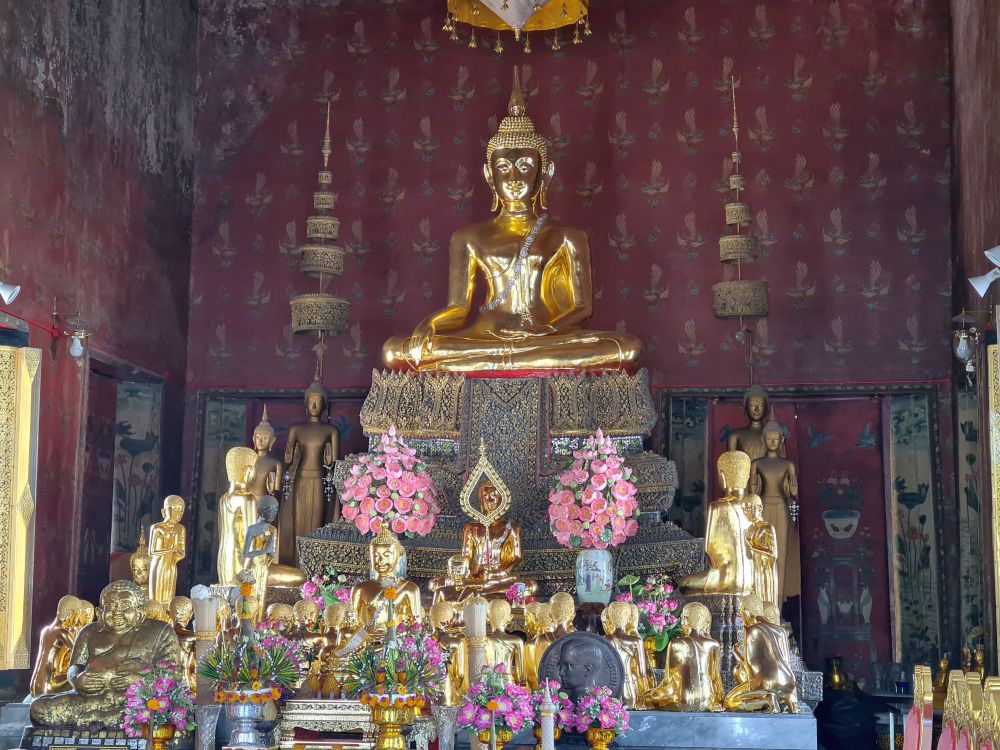
Also notice the pretty little stone sculptures here and there on the grounds. These came in the form of ballast on ships from China, unloaded in Bangkok to make room for goods to ship back to China.
This temple was also home to a royal poet named Sunthorn Phu. If you’re interested, you can visit his former house, now a museum.
Open daily 8:00-17:00. Free admission.
10. Wat Benchamabophit
Started in 1899, Wat Benchamabophit is special particularly because of its extensive use of Italian marble, which is why it’s also called the Marble Temple. I didn’t visit it, but my husband did, and this is what he wrote:
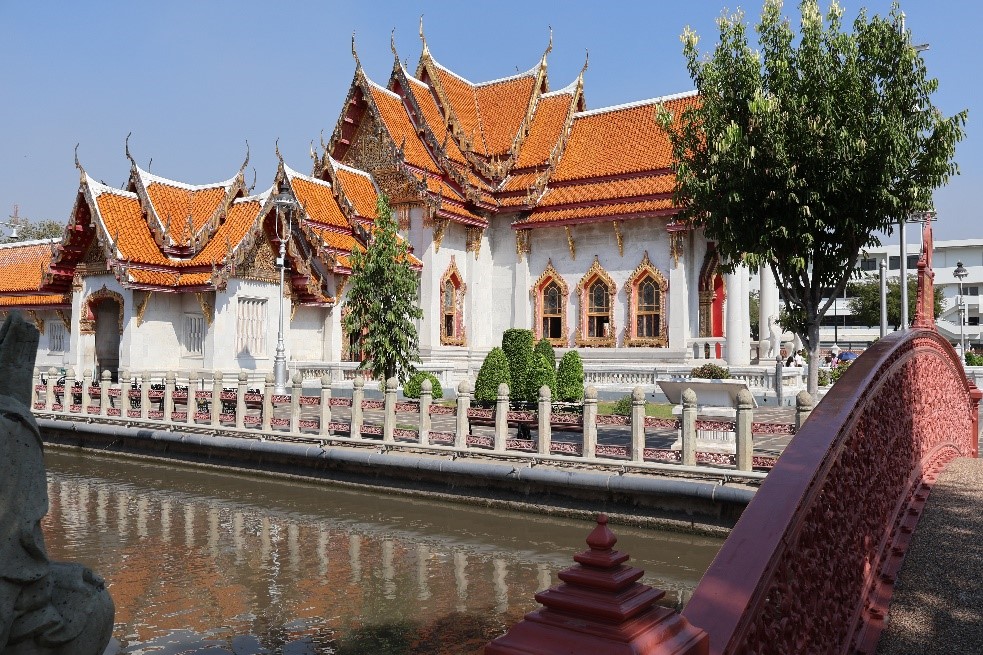
One of the absolutely most beautiful temple complexes is the Wat Benchamabophit. It is beautifully laid out with little canals and bridges all around the complex. The gardens surrounding the temple have intricately-cut trees resembling giant bonsai trees. Then, of course, the temple buildings themselves are very elaborately decorated. Just stunning.
Open daily 6:00-17:00. Admission fee: 20 baht.
11. Wat Intharawihan
This is another one that my husband visited:
This temple, dating from before Bangkok became the capital, was built at the start of the Ayutthaya period in the 15th century. The temple once stood alone in the fields (then called Vegetable Fields Temple) but was given its new name when it was refurbished during the reign of King Rama VI in the early 20th century.
What makes this a must-see temple is the huge standing Buddha next to the ordination hall. It is 32 meters (105 ft) high and 10 meters (33 ft) wide. To the side of it is a narrow stairway up to a little room (I could not go in as it was locked). From the top of the stairs you would have a nice view of the temple complex.

The standing Buddha was finished in 1927 and took almost 60 years to complete. I was truly surprised that during the time of my visit there, I saw only two other tourists. Maybe this is because it is not near any other sights, or because it is not readily visible from any of the main roads as it stands in the center of a block of houses.
Open daily 8:30-20:00. Free admission.
12. Wat Phichaya and 13. Wat Anong
It’s not clear when Wat Phichaya (Wat Phichaya Yatikaram Worawihan or Wat Phichai Yat) was first built, but it was abandoned for some time before its restoration in 1829-32. It’s a particularly pretty temple, with a symmetrical assemblage of structures and pretty decorations of the eaves and doorways. The “twin pagodas” on either side are elegant white stupas with gold detail. The main temple has a large stupa right on top, also detailed in gold.

Wat Anong (Wat Anongkharam Worawihan) is right next to Wat Phichaya and dates to about 1850. If you’re there anyway, it’s worth taking a look because of the beautiful woodwork on the buildings and the many Buddha images. In the late afternoon, if the sun is shining, it glitters.
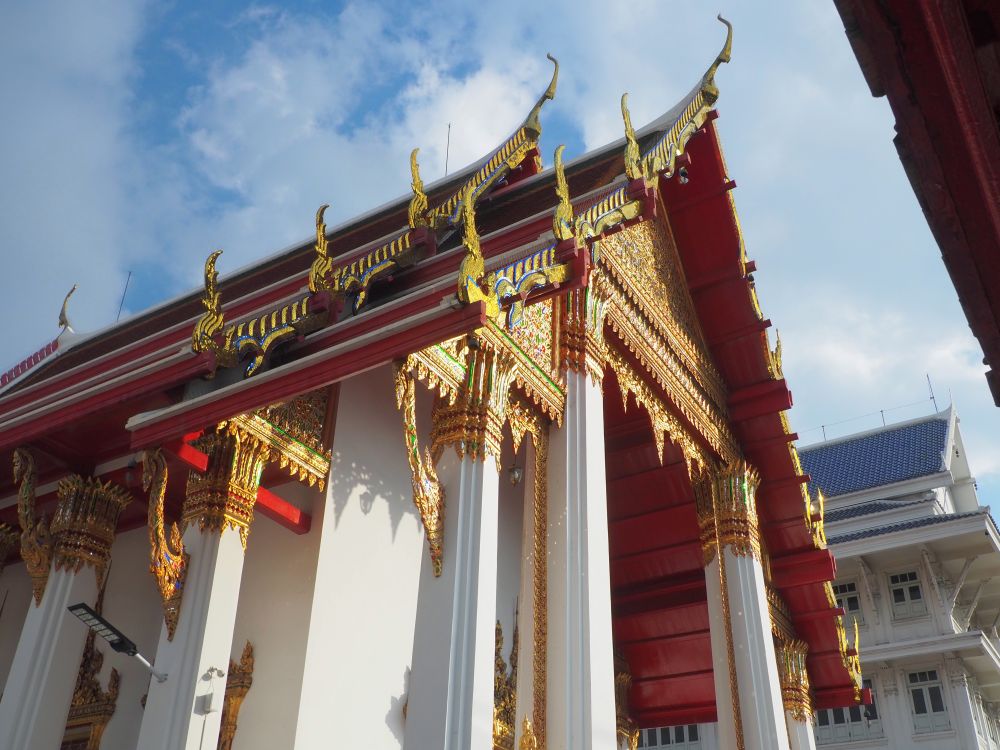
Admission is free to both Wat Phichaya and Wat Anong.
14. Wat Prayun or Wat Prayoon
Wat Prayun (full name: Wat Prayurawongsawas Worawihan) dates to the mid-1800s and is best known for its bright white stupa surrounded by smaller stupas with a circular wall, also white. Unlike many stupas, you can actually enter this one, which offers a glimpse of how such stupas are constructed: brick mostly, with wooden beams for support.
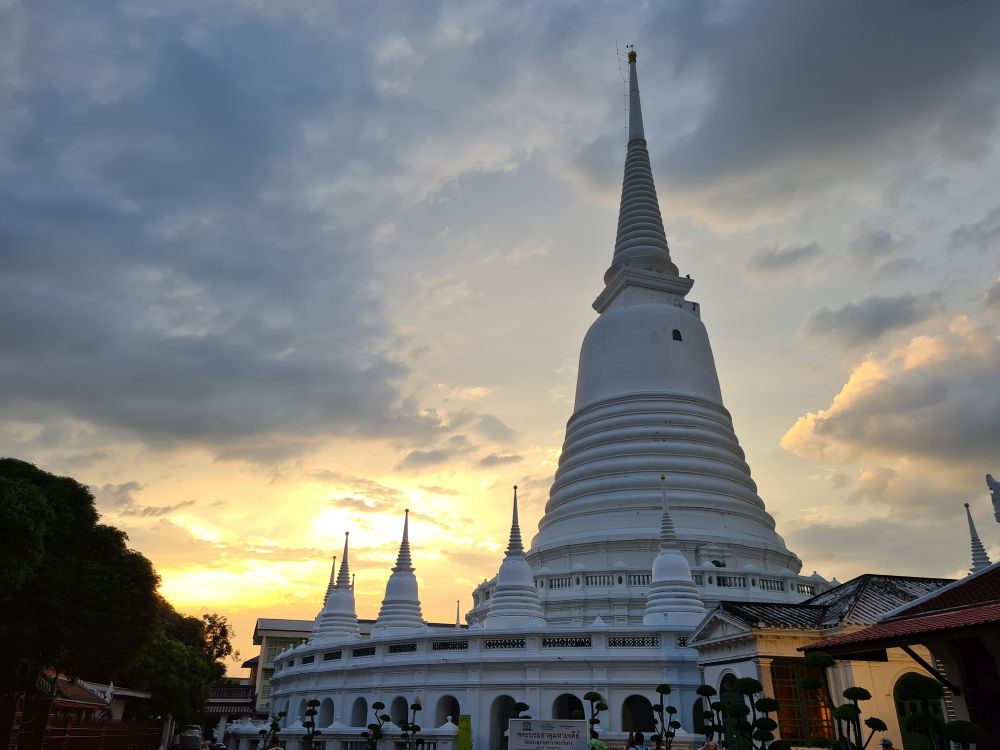
Climb the stairs and you can see views over the rest of the temple complex. The buildings have some lovely detailing under the eaves and form a contrast to the modern buildings behind them. Inside the main temple sits a very large gold-covered Buddha in Subduing Mara pose.
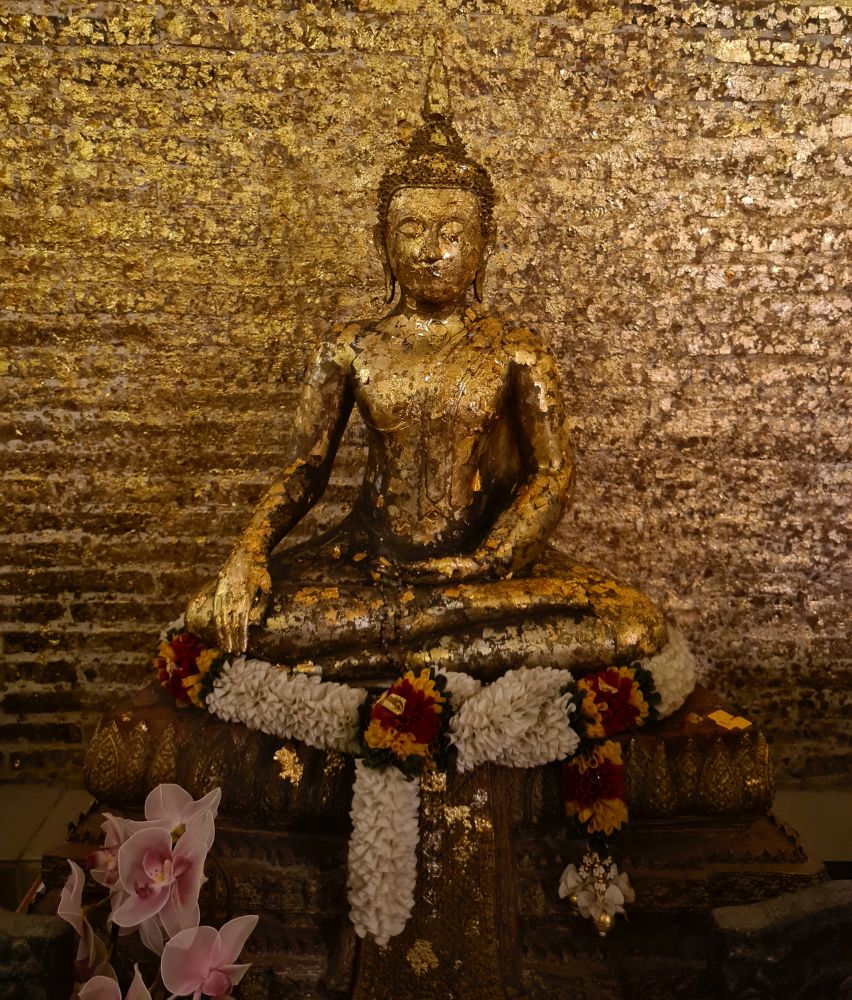
In a garden next door, you can feed the resident turtles. Buy a box of cut fruit in the garden and use the long skewers provided.
Open daily 7:00-18:00. Free admission.
15. Wat Kalaya
About halfway between Wat Arun and Wat Anong, you can find Wat Kalaya (full name: Wat Kalayanamit Woramahawiharn). This temple is another pretty complex, dating to the early 1800s. Its claim to fame, though, is the huge sitting Buddha statue; it’s more than 14 meters high.
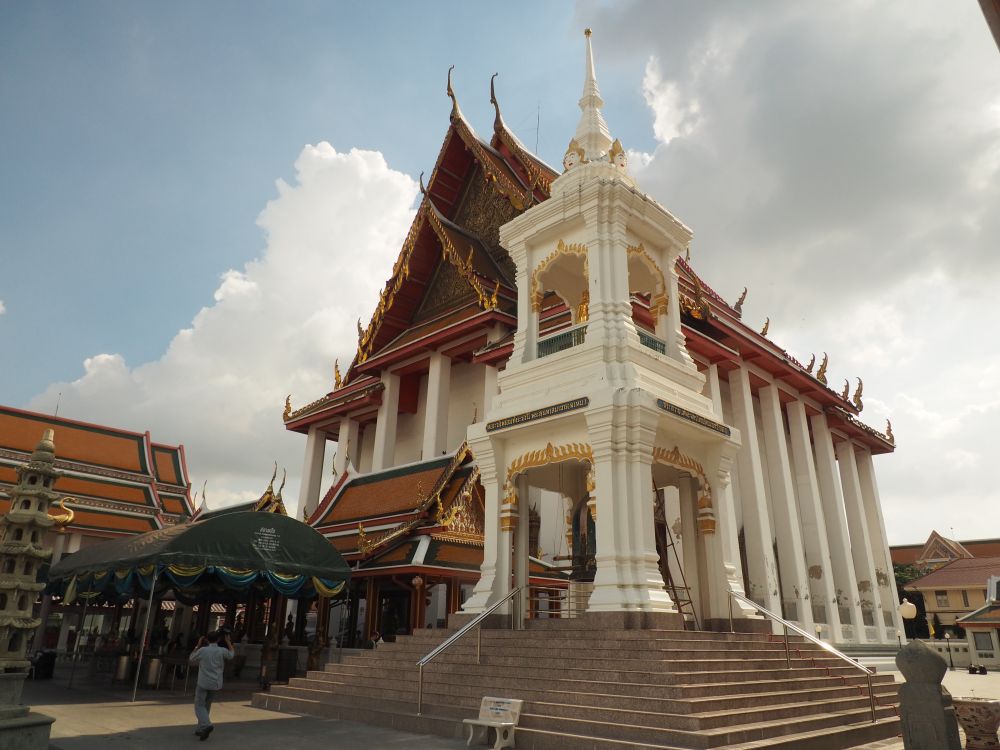
Open daily: 8:00-16:00. Free admission.
16. Wat Suthat Thepwararam
One last one from my husband:
Again, this is a beautiful temple complex. What I really liked about the grounds outside of the two main buildings were the little figurines, presumably portraying stories of the Buddha. The temple was built by King Rama I in 1807. Rama II added the enormous wooden doors and the temple was finished by Rama III in 1847. The temple contains one of the largest (26ft high) surviving Buddhas from the Sukuthai period. It is 800 years old and was moved by King Rama I from Sukhothai to Bangkok.
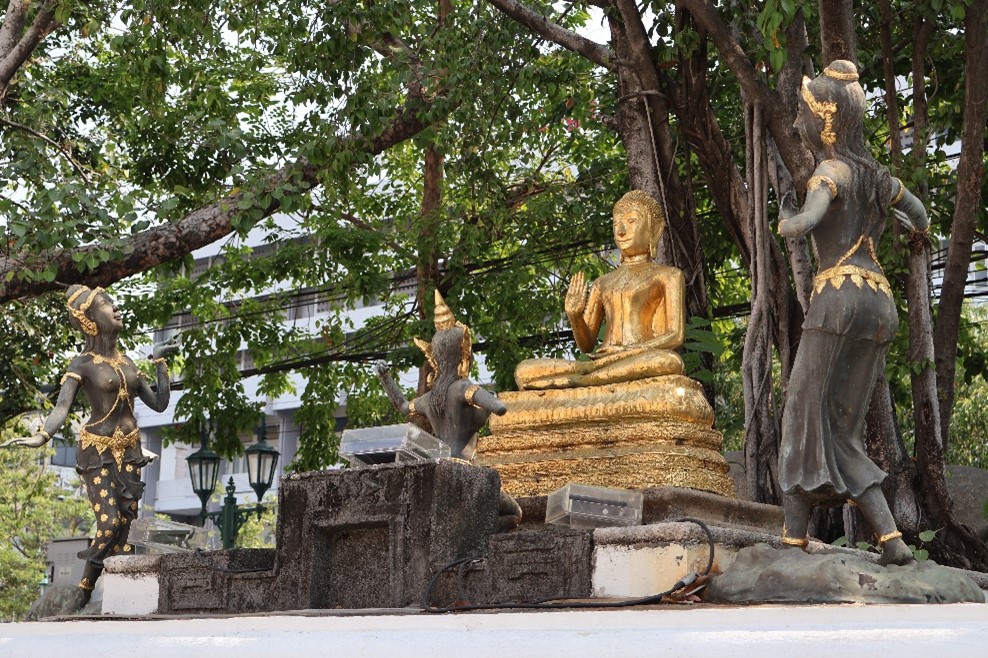
The temple also has fully decorated walls and pillars restored in the 1980s. They relate the story of the Buddha’s previous lives as well as some scenes of daily life in the Ratanakosin era. Around the base of the temple there are 28 Chinese pagodas and in the cloister walls around the temple stand more than 150 Buddhas: some gold, some black. In the long ordination hall stands another large Buddha statue with sitting/praying disciples at his feet.
This temple is little visited by tourists, but it’s definitely worth your time.
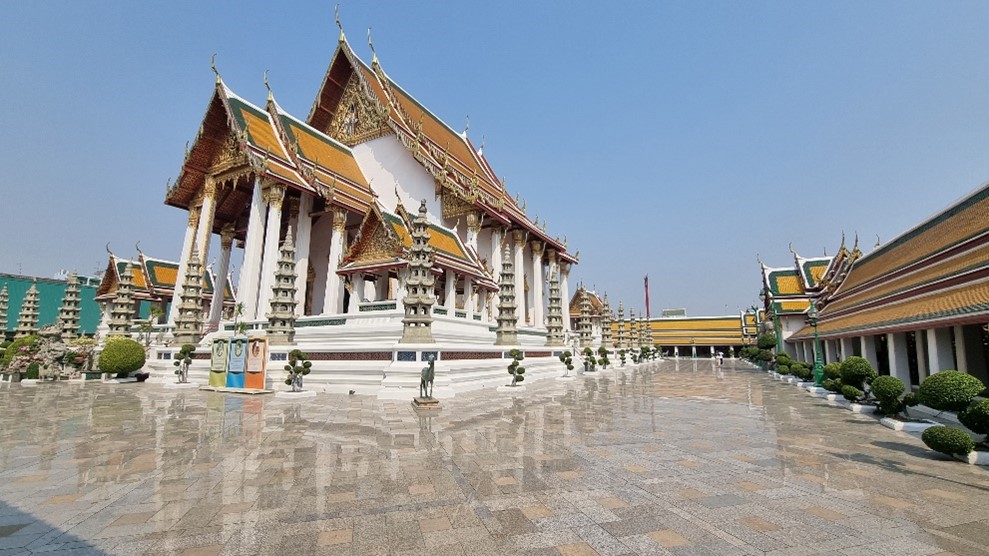
Open daily 8:30-21:00. Admission: 20 baht.
Which temples in Bangkok should you visit?
In any tourist destination, there are sights that get crowded, but there’s usually a good reason: they’re well-known places that have come to be seen as “best” for one reason or another. At the same time, Bangkok is a huge city, so don’t expect to visit many temples in a day unless you take taxis from one to the next. Below is a map so you can figure out which temples are best to visit together.
You’re likely to visit the Grand Palace in any case, so it makes sense to visit the most popular temples, Wat Mahathat and Wat Phra Kaew at the same time. Wat Pho is walking distance away too, and definitely should be high on your list. In my husband’s view, Wat Pho was the most beautiful, though he ranks Wat Benchamabophit second because of the beauty of the garden around it.
Once you’ve seen those three, it’s a matter of how many more temples you’d like to see. Wat Arun is a great place: worth a separate trip (It’s on the west side of the Chao Phraya river, but easy to reach by ferry.), or at least try to get a glimpse of it from the river – at night it’s beautifully lit up.
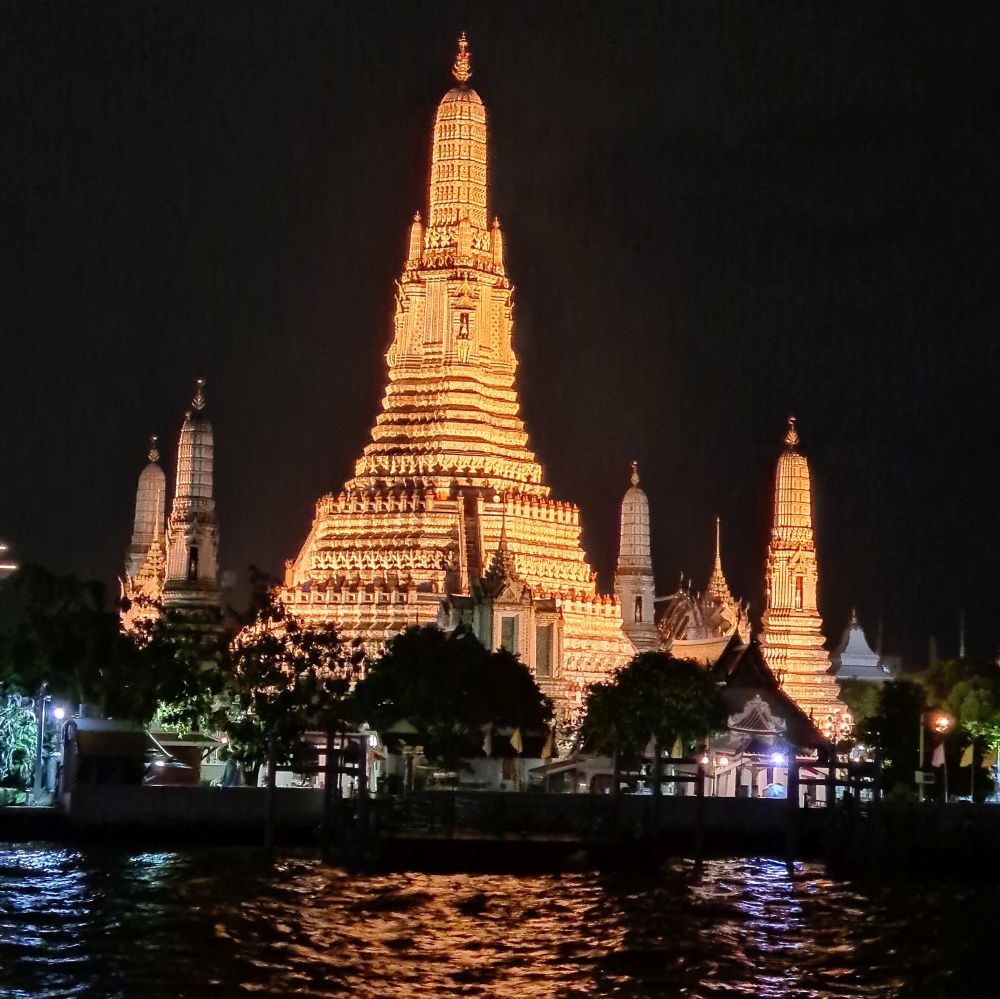
The Golden Mount (Wat Saket) is worth visiting as much for the view as anything else, and combines well with the Metal Castle and Wat Thephidaram.
Wat Traimit isn’t near the others, but I especially enjoyed it because the Chinatown Heritage Center was so interesting. So was learning about the Golden Buddha’s story and seeing it in real life. In any case, being in Chinatown, it could combine well with, say, a Chinatown food tour. (That link goes to the one that I took, which I thoroughly enjoyed.)
Wat Anong and Wat Phitchaya are right next to each other on the Thonburi side of the Chao Phraya river, and Wat Prayun isn’t far away.
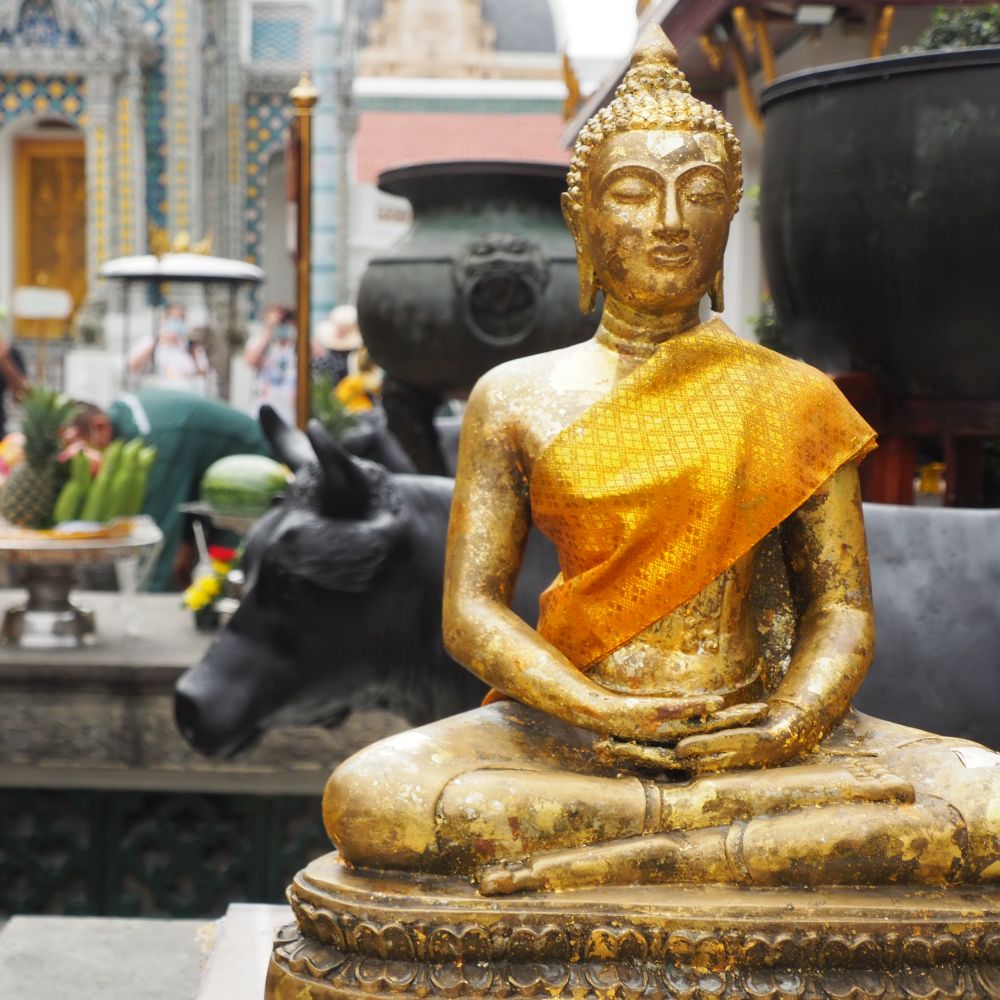
Wat Suthat is worth the effort because the complex is so pretty (and empty) and because of the pretty figurines outside.
Tips for visiting Buddhist temples in Bangkok, Thailand
Buddhist temples have a dress code: dress conservatively. Men should wear long pants and women should wear capri or long pants or a skirt that covers the knees. No tank tops either; keep your shoulders covered. If you show up with clothing that’s too skimpy or too tight, you might have to rent cover-ups to be allowed in.
You’re expected to take off your shoes when visiting any Buddhist temple, so it’s a good idea to wear shoes that are easy to slip on and off. It doesn’t seem to matter if you walk inside on bare feet or socks. There’s usually a shelf outside the entrance where you can leave your shoes. Don’t worry about your shoes getting stolen; no one would dare steal shoes at a temple.
As you enter the temple, take off your hat.
You’ll likely see people kneeling in prayer on the floor in front of the altar. Don’t disturb them. Stay at the back if you’re not praying yourself. If you wish to sit, that’s fine, but never extend the bottoms of your feet toward the Buddha. Don’t take selfies, even if you see locals doing so. It comes off as disrespectful, and in many places is forbidden.
In many temples there’s a raised area, usually carpeted in red, either up right in front of the altar or along the left side of the room (as you face the Buddha). This is reserved for monks, who use the area to walk and meditate at the right hand of the Buddha. Do not step or sit on this area.
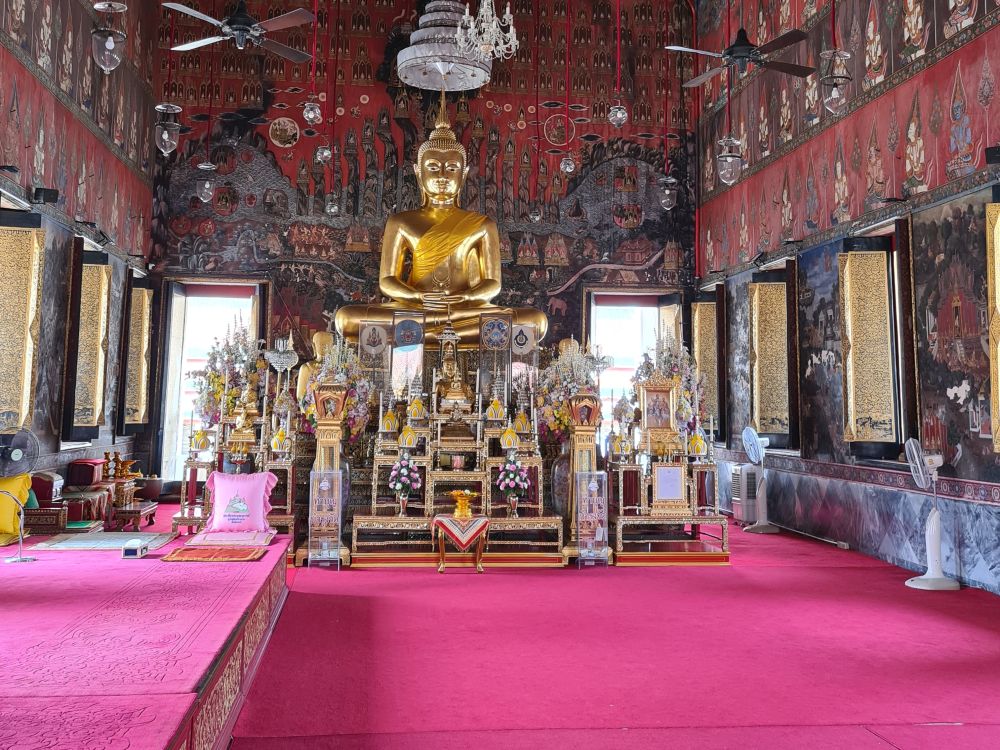
Many of the buildings in a large temple complex are off-limits to visitors: the monks’ quarters, for example. There will generally be signs, but they might only be in Thai. Be prepared with a translation app on your phone – I use Google Translate – that allows you to point your phone’s camera at written text and get a translation. If you’re not sure, don’t enter!
On a more mundane topic, many temples offer public toilet facilities. These are usually clean and tidy; please keep them this way. Some may not provide toilet paper, so it’s a good idea to have a supply of your own. Some do supply toilet paper, but it’s outside the stalls, so you need to remember to take some before you go in. In some cases, signs will warn you not to flush any toilet paper, in which case there’s a bin for you to use. Even if you can flush it, use toilet paper sparingly.
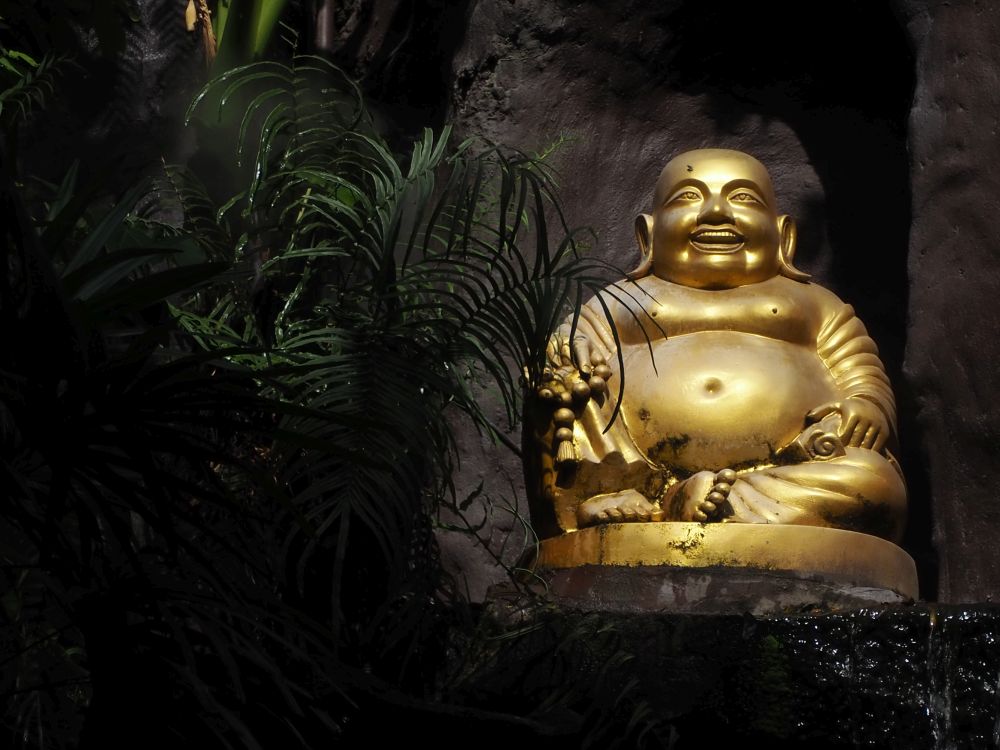
Where to stay in Bangkok
Obviously a big city like Bangkok has thousands of accommodations, and I certainly can’t tell you about them all. What I can tell you is that I’ve stayed at a total of 10 different accommodations in Bangkok, ranging from 2-5-star level. You can read about all of them in my article: 10 places to stay in Bangkok (where I have actually stayed).
If none of the accommodations in that article appeal to you, look at your other accommodation options here.
Do you like to visit temples like these? Or have you visited any of the Bangkok temples I’ve listed? What did you think? Add a comment below!
My travel recommendations
Planning travel
- Skyscanner is where I always start my flight searches.
- Booking.com is the company I use most for finding accommodations. If you prefer, Expedia offers more or less the same.
- Discover Cars offers an easy way to compare prices from all of the major car-rental companies in one place.
- Use Viator or GetYourGuide to find walking tours, day tours, airport pickups, city cards, tickets and whatever else you need at your destination.
- Bookmundi is great when you’re looking for a longer tour of a few days to a few weeks, private or with a group, pretty much anywhere in the world. Lots of different tour companies list their tours here, so you can comparison shop.
- GetTransfer is the place to book your airport-to-hotel transfers (and vice-versa). It’s so reassuring to have this all set up and paid for ahead of time, rather than having to make decisions after a long, tiring flight!
- Buy a GoCity Pass when you’re planning to do a lot of sightseeing on a city trip. It can save you a lot on admissions to museums and other attractions in big cities like New York and Amsterdam.
- Ferryhopper is a convenient way to book ferries ahead of time. They cover ferry bookings in 33 different countries at last count.
Other travel-related items
- It’s really awkward to have to rely on WIFI when you travel overseas. I’ve tried several e-sim cards, and GigSky’s e-sim was the one that was easiest to activate and use. You buy it through their app and activate it when you need it. Use the code RACHEL10 to get a 10% discount!
- Another option I just recently tried for the first time is a portable wifi modem by WifiCandy. It supports up to 8 devices and you just carry it along in your pocket or bag! If you’re traveling with a family or group, it might end up cheaper to use than an e-sim. Use the code RACHELSRUMINATIONS for a 10% discount.
- I’m a fan of SCOTTeVEST’s jackets and vests because when I wear one, I don’t have to carry a handbag. I feel like all my stuff is safer when I travel because it’s in inside pockets close to my body.
- I use ExpressVPN on my phone and laptop when I travel. It keeps me safe from hackers when I use public or hotel wifi.


